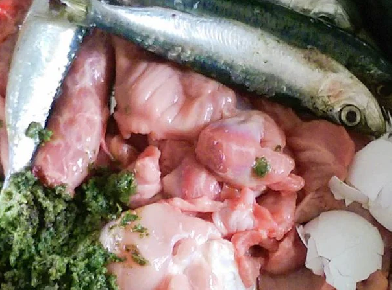The BARF diet is not as strange as its name suggests; you may have heard of it and maybe laughed at the name. The acronym "BARF" refers to "Biologically Appropriate Raw Food," and the purpose of this diet is to improve your pet's health and lifespan while reducing the risk of developing certain diseases. A BARF diet is explained by experts, along with its benefits and drawbacks.
What Is the BARF Diet?
BARF is an abbreviation for "biologically appropriate raw food," often known as "bones and raw foods." This diet, as the name suggests, consists mainly of raw flesh and bones, although it also includes:
- Fresh fruits and vegetables
- Dairy
- Whole grains
- Supplements rich in vitamins and minerals
A diet that is based on raw animal proteins is intended to resemble the way a dog might eat in the wild, and it provides higher quantities of protein than the majority of typical commercial pet diets (particularly dry formulations). The likelihood that your dog will experience an allergic reaction, develop a food intolerance, or put on weight from too many carbohydrates and fats is significantly reduced because nearly no element of a raw meal is processed.
In comparison to the majority of commercial pet foods, raw dog food diets provide greater protein. Additionally, they don't include the processed meat, vegetables, and grains found in most commercial dog dietary regimens. Going raw can greatly enhance your dog's health, including eliminating digestive issues, lowering allergies, and assisting your pet in maintaining a healthy weight.

Pros of Barf Diet for Dogs
Due to the fact that BARF diets do not include heat-processed products, no nutrients are lost in the transition from source to bowl. Protein is the most important of these nutrients since it serves as a dog's major source of energy and helps build and maintain healthy muscle and other tissues. The protein component in many commercially available canned and kibble dog foods becomes less effective due to high cooking temperatures.
The majority of a dog's diet is digested as waste since protein cannot be retained in a dog's body. A dog will continue to eat if a protein source is not providing the necessary amount of energy. That's why people who feed their dogs a BARF diet report that their canine companion eats less at each meal: the protein source maintains its natural efficiency, providing all the energy your dog needs without making him feel hungry.
Canned and kibbled commercial dog food made with grains may fill them up, but they won't get the same nutritional value from it as they would from a BARF diet. Many dog owners find that a grain-rich diet can be extremely irritating to their dog's epidermis and digestive system.
Cons of Barf Diet for Dogs
Despite the fact that the benefits of a BARF diet significantly outweigh the risks, there are a few things to keep in mind when transitioning your dog.
Food hygiene is the top priority. Many dog owners are concerned about their dogs being exposed to food-borne pathogens like Salmonella and Escherichia coli. The possibility of contamination from these germs is real, although it is more likely to occur in humans than in dogs. Bear in mind that in the wild, dogs frequently consume raw meat.
Since humans prepare the food, the same precautions must be taken to prevent cross-contamination as when you prepare your own meals:
- Before cooking, rinse all beef cuts.
- Use cutlery and other tools that are clean.
- Clean each tool thoroughly after each use.
- Hands should always be completely washed before and after handling raw meat.
- Avoid cross-contamination by preparing and storing raw foods in a separate location from cooked foods and keeping them between 32° to 42° F.










0 Comments